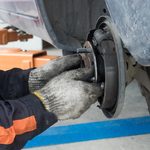What It Could Mean If Your Car Makes a Clicking Noise When Starting

The diagnosis depends on whether it's clicking once, or a series of rapid clicks. Either way, there's some maintenance in order.
The most common reason for that rapid clicking noise when your car fails to start is a dead battery. However, a single click could mean a malfunctioning starter motor, or something even more ominous. Here are the most frequent reasons why a starter clicks when you’re trying to start your car.
Car Starting Basics
Turning the ignition key or pushing the “Start” button sends battery power flowing through the ignition switch to the starter relay or starter solenoid and computer (ECM). The relay/solenoid is the switch that engages the starter motor. That sends full battery power to the starter motor, engaging a pinion gear (also referred to as a Bendix Drive) that meshes with and spins the flywheel ring gear. The flywheel turns the crankshaft which gets the pistons moving up and down in the cylinders.
The ECM meters air and fuel into the cylinders and signals the ignition system when to fire the spark plugs, igniting the air/fuel mixture compressed by the pistons. And then your engine starts!
So What’s That Clicking Noise?
Clicking when starting usually means the starter motor pinion gear is crashing into the flywheel due to a depleted battery that doesn’t have enough “juice” to spin the engine. (Learn how to test a car battery.)
Multiple clicks (rapid clicking)
Rapid clicking usually indicates there is enough power in the battery to bring the starter motor to life but not enough to crank the engine. When it can’t get your engine spinning, the starter motor turns off and on. Each time it turns on, the teeth of the pinion gear clatter against the teeth of the flywheel. That’s the clicking that you hear.
Single click
A single loud click when starting (even after trying to jump-start your battery) is usually caused by a faulty starter motor, starter relay/solenoid or other electrical problem. However, if your engine has locked up (seized) the starter pinion will smash into the flywheel, making a loud clunking noise as it tries to crank the engine.
What To Do When Your Car Won’t Start (Multiple Clicks)
Jump-start the battery
Safety warning: A car battery contains sulfuric acid that can cause serious burns. Always wear gloves and eye protection when working around a battery or jump-starting a car. If you come into direct contact with battery acid, flush with plenty of water and get medical attention immediately.
Jump-starting your car while following all safety precautions is typically the quickest way to start your car when you hear clicking. (Here’s how to jump start a car safely.)
Battery Terminals
Battery cables are attached to your battery at battery terminals. If the terminal connections are corroded or loose, electrical power flow from the battery to the starter is reduced, keeping your car from starting even with a jump.
Removing the cable ends, cleaning off the corrosion with a wire brush and retightening the bolts should restore full electrical power to your car. Also, check that the negative battery cable connection at the engine block is clean and tight.
Starter Motor
Clicking or grinding sounds when trying to start your car can be a sign the starter motor has failed and may also be the reason a jump was unsuccessful.
Excessive cranking due to a hard-start condition can overheat a starter motor, damaging internal mechanical or electrical components leaving the starter unable to “crank” the engine. Also, a loose or corroded starter relay wire or connection will cause battery voltage to drop before reaching the starter.
Let your mechanic diagnose starter motor problems.
Charging System Problems
A defective alternator can keep a battery from fully charging. A worn or loose drive belt or a weak belt tensioner will also keep a battery from fully charging. Replacing a drive belt is a DIY task but leave alternator/charging problems to the experts.
What To Do When My Car Won’t Start (Single Click)
Jump-start the battery
Jump-starting is still the simplest DIY task if your car doesn’t crank. Sometimes the power of two batteries (your car’s and a helper battery) can free up a stuck starter motor.
Whack the starter
If you can safely reach the starter motor, try banging it with a hammer, your shoe or the tire iron from your trunk. Sometimes the electrical contacts get stuck and can be freed by tapping on the starter.
Recycle the key
Turn the key to the “Start” position (or push the “Start” button) 10 times in a row. Wait five minutes, and then try to start your engine. Call for a tow if these fixes don’t work. (Here’s more advice on what to do when your car won’t start.)
The Last Word
Although there is no basic starter motor maintenance, weak batteries and starting and electrical system problems shorten starter motor life. Problems causing extended cranking should be promptly diagnosed and repaired.
Once a month, check that your battery terminals are clean and tight, battery fluid levels (in batteries with removable caps) are correct and the battery is secured. That can prevent damage while prolonging battery and starter motor life.
Next, find out what nine other strange car noises could mean.






